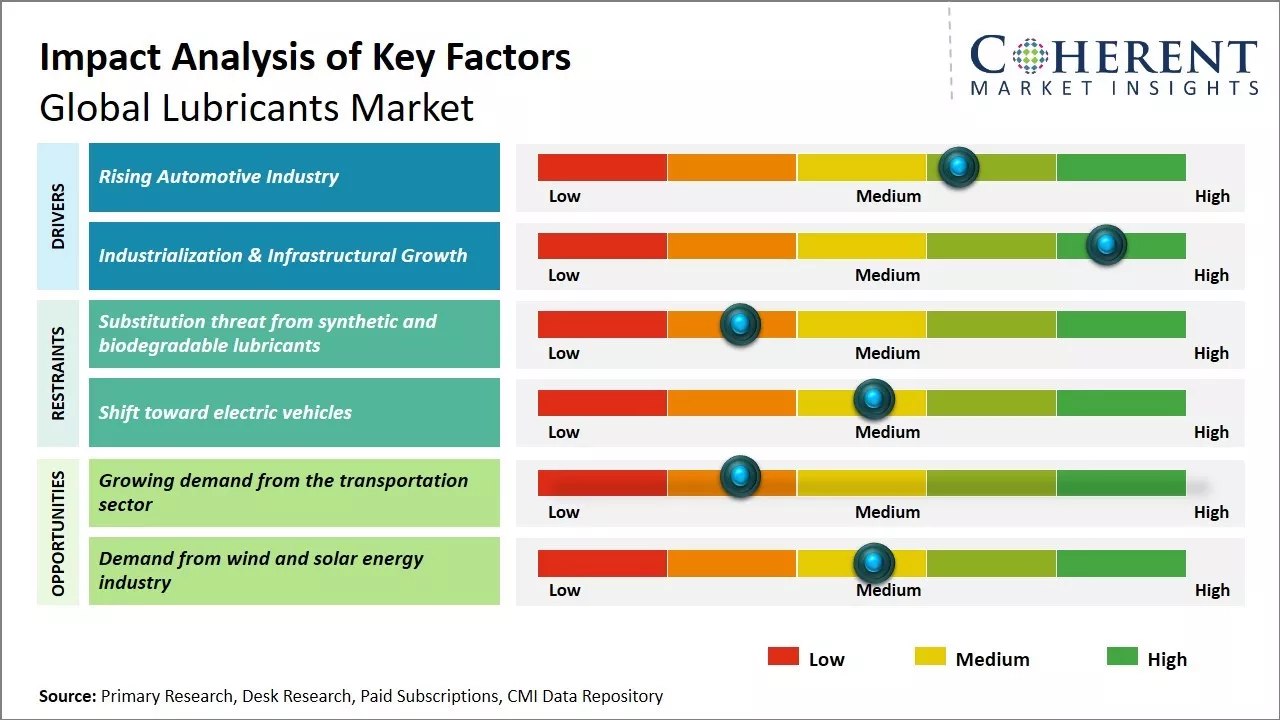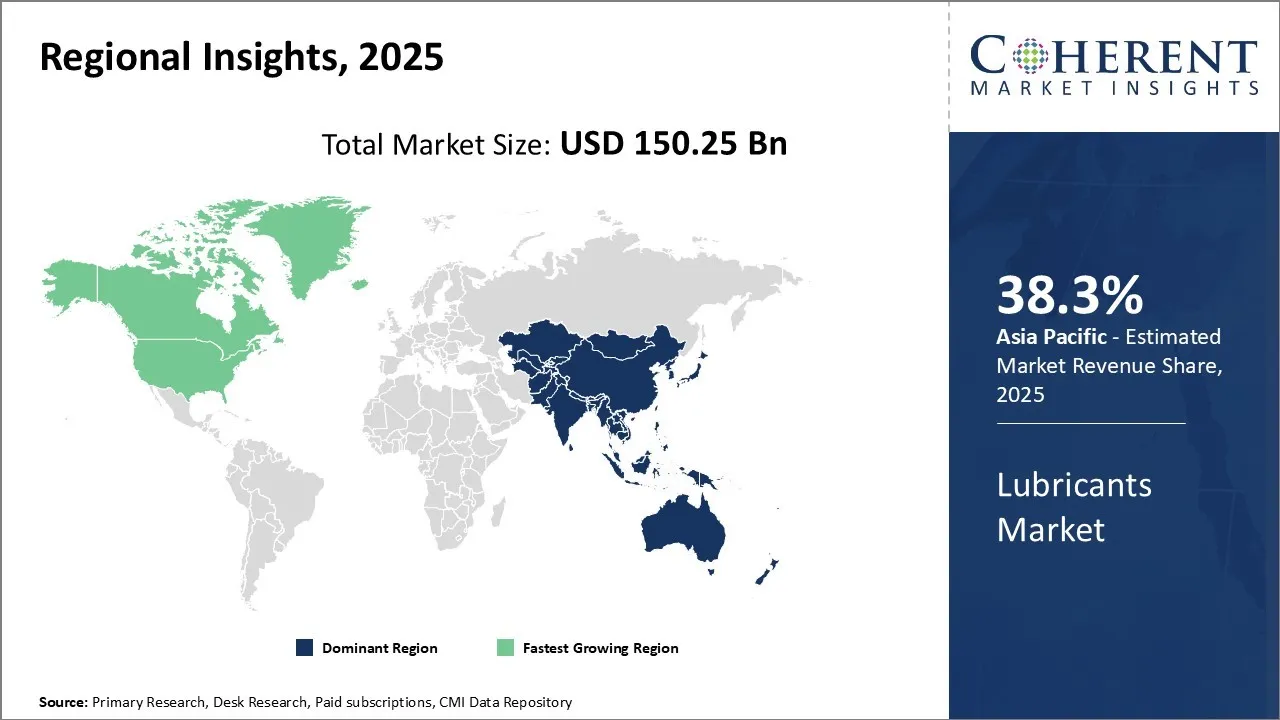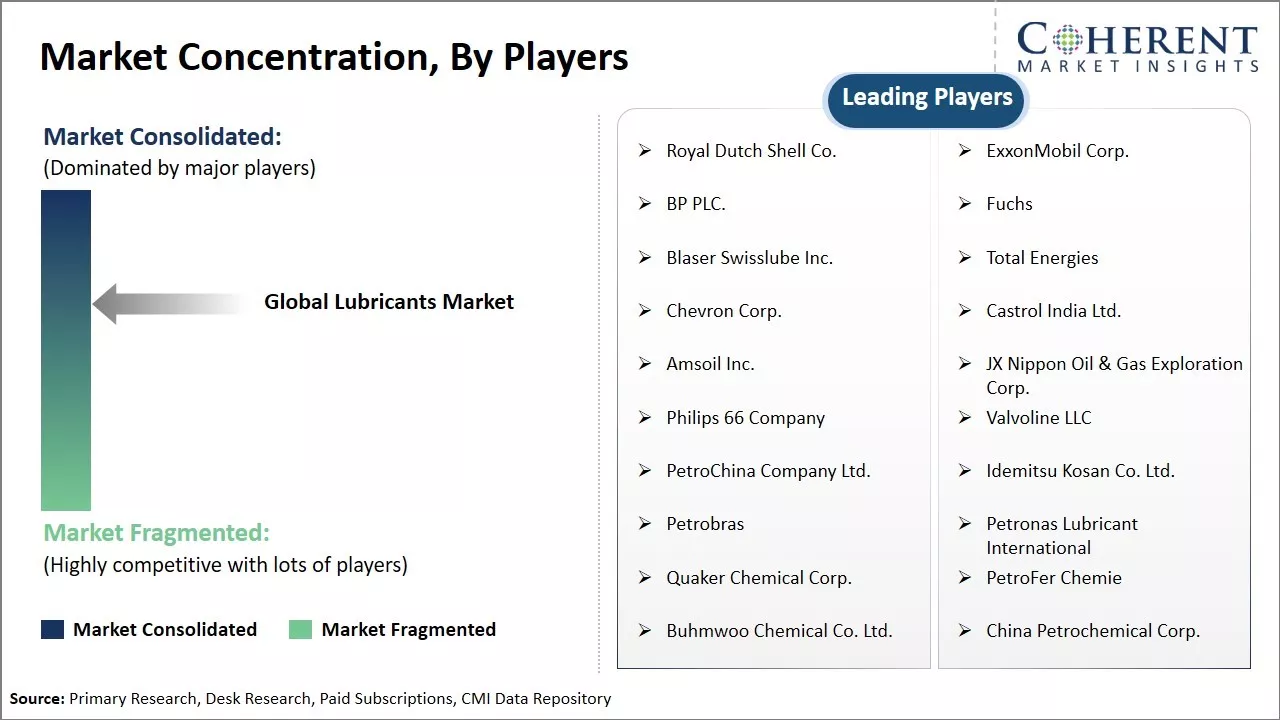Global lubricants market is estimated to be valued at USD 150.25 Bn in 2025 and is expected to reach USD 196.53 Bn by 2032, exhibiting a compound annual growth rate (CAGR) of 3.9% from 2025 to 2032.

To learn more about this report, Download Free Sample
The demand for automotive lubricants is likely to increase due to rising production and sales of vehicles. Growing manufacturing activity along with increasing consumption of machinery and equipment across industries is expected to boost demand for industrial lubricants. Rapid industrialization and urbanization in emerging economies are further expected to create new opportunities for lubricant manufacturers over the coming years. However, stringent environmental regulations regarding carbon emissions may negatively impact the growth of the market. Innovative product development and use of bio-based and synthetic lubricants are expected to provide opportunities for sustainable growth in the global lubricants market.
|
Current Event |
Description and its Impact |
|
Global Electric Vehicle Transition and Automotive Electrification |
|
|
Advanced Lubricant Technology Development and Regulatory Changes |
|
Uncover macros and micros vetted on 75+ parameters: Get instant access to report
|
Oil Type |
Average Price (USD/liter) |
Key Drivers |
|
Mineral Oil |
$1.50 – $2.50 |
Abundant supply, basic performance |
|
Synthetic Oil |
$3.50 – $6.00 |
High performance, longer life, emission compliance |
|
Semi-Synthetic |
$2.50 – $3.50 |
Balanced cost and quality |
|
Bio-Based Oil |
$4.00 – $7.00 |
Eco-friendly, niche applications |
|
Hydraulic Oil |
$2.50 – $4.50 |
Industrial demand, anti-wear properties |
|
Gear Oil |
$3.00 – $6.00 |
High viscosity, heavy-duty protection |
|
Compressor Oil |
$3.00 – $5.00 |
Low volatility, oxidation resistance |
|
Turbine Oil |
$3.50 – $5.50 |
Thermal stability, anti-rust |
|
Transformer Oil |
$2.50 – $4.00 |
Electrical insulation, dielectric strength |
|
Cutting Oil |
$2.00 – $4.00 |
Cooling and lubrication in machining |
|
Engine Oil |
$2.00 – $5.00 |
Friction reduction, engine protection |
Uncover macros and micros vetted on 75+ parameters: Get instant access to report
In terms of base oil, mineral oil segment is estimated to contribute the 41.3% share of the market in 2025, owing to its widespread industrial applications. Mineral oil is derived from crude oil through conventional refining and offers strong heat and oxidation resistance at relatively low costs. These attributes make it highly suitable for lubricating engines, turbines, compressors, and other moving parts in various industries. As industries across sectors continue to scale up operations amid rapid urbanization and economic growth worldwide, demand for heavy-duty machinery and equipment is rising exponentially. This directly boosts consumption of mineral oil-based lubricants used for hydraulic systems, bearings, gears, and other industrial machinery.
For instance, in August 2025, Shell India targeted growth in the synthetic lubricant segment, which currently holds just 20% market share in India. With its premium product Helix Ultra, Shell aims to shift consumer preference from mineral oil-based lubricants to synthetic alternatives, citing better engine protection and efficiency. The company sees rising awareness and demand as key growth drivers.
In terms of product type, engine oil segment is estimated to contribute the 37.2% share of the market in 2025, owing to continuous efforts by automakers to enhance fuel efficiency. Engine oil forms the lifeblood of automobile engines and helps in critical functions like engine cooling, rust and corrosion protection. With governments across regions imposing stringent fuel efficiency and emission standards, automakers are focusing on engine downsizing and optimization techniques. Technologies like turbocharging and direct fuel injection enable remarkable improvements in engine performance but also place higher thermal and operational stresses on engine parts. This has prompted engine oil manufacturers to innovate formulations with advanced detergency properties to remove sludge, keep engines clean and facilitate optimal fuel combustion.
For instance, in July 2025, Castrol unveiled its new MHP lubricant range, MHP 1-30 and MHP 1-40, tailored for four-stroke medium-speed marine engines. Designed to support engines running on distillate fuels, LNG, and biofuels, the oils promise improved cleanliness, wear protection, and longer oil drain intervals. The launch follows extensive testing totaling over 30,000 hours.
In terms of end user, automotive and other transportation segment is estimated to contribute the 34.9% share of the market in 2025, driven by growing mobility needs worldwide. Countries are aggressively undertaking projects in sectors like construction, mining, power generation, manufacturing, and agriculture requiring heavy machinery. Lubricants form an integral part of heavy equipment and play crucial roles like dampening friction between moving parts, carrying away heat, protecting against rust and corrosion. Modern heavy equipment is engineered for maximum uptime and efficiency necessitating continuous lubrication. This stimulates sales of heavy-duty lubricants customized for excavators, cranes, bulldozers, drilling machines and other tools.
For instance, in October 2025, SK Enmove partnered with Gabriel India to launch a joint venture focused on premium automotive lubricants. The collaboration aims to introduce high-performance products tailored for Indian vehicles, leveraging SK Enmove’s advanced technology and Gabriel’s market presence. This strategic move targets growing demand for quality lubricants in both passenger and commercial vehicle segments.

To learn more about this report, Download Free Sample
The Asia Pacific has established itself as the dominant region with 38.3% share in 2025. Countries like China, India and Indonesia have witnessed massive growth in their industrial and automotive sectors which has fueled the demand for lubricants. China, in particular, has become the largest automotive market as well as a global manufacturing hub. Both these factors have significantly boosted the consumption of automotive and industrial lubricants.
In addition, the rapidly expanding populous middle-class in the region has increased demand for consumer goods and appliances, thus driving the volume growth of lubricants through the process of lubrication. While domestic demand serves as the key growth driver, Asia Pacific has also turned into a prominent trade zone for lubricants worldwide.
For instance, in March 2025, Motul launched its eco-friendly NGEN lubricant range in the Asia Pacific, featuring NGEN 5 and NGEN 7 engine oils. Designed for motorcycles and hybrid vehicles, these oils use up to 75% regenerated base oils and come in recycled plastic packaging. The initiative reflects Motul’s commitment to sustainable, high-performance mobility solutions.
North America is anticipated be the fastest growing region in lubricants market globally. The region enjoys a strong presence of key lubricant manufacturers as well as a robust industrial sector that demands significant volumes of lubricants across various end-use verticals such as automotive, industrial machinery, and metalworking. Countries like the U.S. and Canada have very well-developed automotive and transportation industries that are among the largest consumers of automotive and industrial lubricants.
For instance, in October 2025, Liqui Moly commenced local motor oil production in the USA to serve domestic and Asian automotive markets. This strategic expansion aims to improve supply chain efficiency and meet rising demand for high-quality lubricants. The move marks a significant step in Liqui Moly’s global growth and commitment to regional market responsiveness.
China’s lubricant market demand in 2025 is driven by its vast industrial base, expanding automotive sector, and growing adoption of high-performance synthetic oils. Increased vehicle ownership, infrastructure development, and stricter environmental regulations are fueling the shift toward advanced lubricants. The country’s push for cleaner technologies also boosts demand for eco-friendly and efficient formulations.
For instance, in July 2025, Lubrizol supported the launch of a new hybrid engine lubricant in Shanghai, China, in collaboration with one of the country’s leading independent lubricant brands. The product is designed to meet the unique demands of hybrid vehicles, offering improved fuel efficiency and engine protection. This marks a key step in advancing China’s lubricant innovation.
In 2025, the U.S. lubricant market sees strong demand due to its vast automotive fleet, industrial activity, and adoption of synthetic and specialty lubricants. Technological advancements, sustainability goals, and stringent emission regulations drive the need for high-performance formulations. Growth in electric vehicles also boosts demand for innovative lubricant solutions tailored to modern engines.
For instance, in November 2025, Starfire Lubricants expanded its operations with a new 104,000 sq. ft. facility in Hamilton, Ohio. The state-of-the-art site enhances manufacturing and distribution capabilities to meet growing demand for high-quality lubricants. This strategic investment strengthens Starfire’s presence in the U.S. market and supports its commitment to innovation and customer service.
| Report Coverage | Details | ||
|---|---|---|---|
| Base Year: | 2024 | Market Size in 2025: | USD 150.25 Bn |
| Historical Data for: | 2020 To 2024 | Forecast Period: | 2025 To 2032 |
| Forecast Period 2025 to 2032 CAGR: | 3.9% | 2032 Value Projection: | USD 196.53 Bn |
| Geographies covered: |
|
||
| Segments covered: |
|
||
| Companies covered: |
Royal Dutch Shell Co., ExxonMobil Corp., BP PLC., Fuchs, Blaser Swisslube Inc., Total Energies, Chevron Corp., Castrol India Ltd., Amsoil Inc., JX Nippon Oil & Gas Exploration Corp., Philips 66 Company, Valvoline LLC, PetroChina Company Ltd., Idemitsu Kosan Co. Ltd., Petrobras, Petronas Lubricant International, Quaker Chemical Corp., PetroFer Chemie, Buhmwoo Chemical Co. Ltd., China Petrochemical Corp. |
||
| Growth Drivers: |
|
||
| Restraints & Challenges: |
|
||
Uncover macros and micros vetted on 75+ parameters: Get instant access to report
Global automotive industry has witnessed robust growth in the recent years with rising vehicle production and sales worldwide. According to various estimates, there were around 60 million passenger cars and commercial vehicles manufactured across major markets in 2017 alone. As vehicle fleet increases globally with higher automobile ownership, it directly leads to higher demand for various automotive lubricants. Lubricants such as engine oil, gear oil, brake fluid, grease, and others are critical components for smooth functioning as well as increasing the lifespan of different vehicle parts that are subjected to friction and wear during operations. Most vehicles require oil change and fluid check or refill at regular intervals as per manufacturer's guidelines. This recurring demand from aftermarket sustains consistent sales of lubricant products even after the sale of new vehicles. With developing countries increasingly adopting personal motorization, their vehicle parc is expected to rise exponentially in coming years.

To learn more about this report, Download Free Sample
Majority of lubricants consumed worldwide are utilized for various industrial machinery and equipment deployed across wide-ranging sectors. Whenever there is new infrastructural construction or capacity expansion taking place in any industry, it leads to higher installation of new plants, assembly lines, mining equipment, and energy plants. All of this machinery demand application of lubricants for smooth functioning of their mechanical parts as well as to reduce friction between moving components. As globalization accelerates manufacturing activities and various emerging economies vigorously pursue industrialization, their needs for industrial lubricants proliferate concurrently. For instance, rapid growth of sectors such as power generation, steel, cement and mining in Asia Pacific nations have substantially escalated regional lubricant consumption in industrial segment. Ongoing investments in infrastructure modernization of urban centers and smart city projects also create incremental demand for lubricating specialized construction equipment and machinery engaged in these large-scale developments. Therefore, continued industrial upgrading and infrastructure growth worldwide can drive the growth of global lubricants market.
Growing demand from the transportation sector due to increasing vehicle fleet is estimated to boost the sales of lubricants. Additionally, rapid industrialization and infrastructure growth in emerging nations of Asia and Africa will propel the demand for lubricants from various machinery and equipment employed. New product launches catering to evolving emission standards also allows companies to gain an edge over competitors in the lubricants market forecast.
The lubricants market value is undergoing a decisive structural shift, where value is migrating from high-volume conventional engine oils toward synthetic, specialty, and bio-based formulations. Electrification is gradually reducing long-term demand for passenger-car engine oils; electric-vehicle sales grew by over 25% in Q1 2024 compared with the previous year, intensifying pressure on legacy lubricant portfolios. However, this headwind is counterbalanced by rapid premiumisation. Synthetic lubricant penetration in key growth markets such as India remains near 20%, highlighting significant room for conversion to higher-margin products. Industrial users are simultaneously prioritizing machinery uptime, driving adoption of engineered lubricants, longer drain-interval solutions, and service-led lubrication management.
Sustainability is accelerating portfolio realignment. Procurement policies in marine, forestry, food, and government sectors are increasingly favoring biodegradable and low-toxicity lubricants, prompting suppliers to expand certified bio-based lines. Recent consolidation, such as global majors acquiring specialty formulators in India which reflects the industry’s strategic pivot toward technical niches and localized manufacturing capabilities.
Overall, competitive advantage will belong to firms that shift from selling volume to selling performance, reliability, and compliance. Differentiation through OEM-approved synthetics, condition-monitoring services, and proven sustainability credentials will determine margin resilience, while price-driven commodity players face progressive erosion of relevance.
Definition: Global lubricants market consists of various types of lubricating oils and greases used to reduce friction between moving parts and components. Lubricants are essential for transportation vehicles as well as numerous industrial applications across sectors like construction, mining, food processing, and manufacturing. The global lubricants industry provides lubricating formulations for engines, transmission systems, hydraulic equipment, and other machining operations requiring lubrication to optimize efficiency and minimize equipment wear and tear.
Share
Share
About Author
Yash Doshi is a Senior Management Consultant. He has 12+ years of experience in conducting research and handling consulting projects across verticals in APAC, EMEA, and the Americas.
He brings strong acumen in helping chemical companies navigate complex challenges and identify growth opportunities. He has deep expertise across the chemicals value chain, including commodity, specialty and fine chemicals, plastics and polymers, and petrochemicals. Yash is a sought-after speaker at industry conferences and contributes to various publications on topics related commodity, specialty and fine chemicals, plastics and polymers, and petrochemicals.
Missing comfort of reading report in your local language? Find your preferred language :
Transform your Strategy with Exclusive Trending Reports :
Frequently Asked Questions
Joining thousands of companies around the world committed to making the Excellent Business Solutions.
View All Our Clients